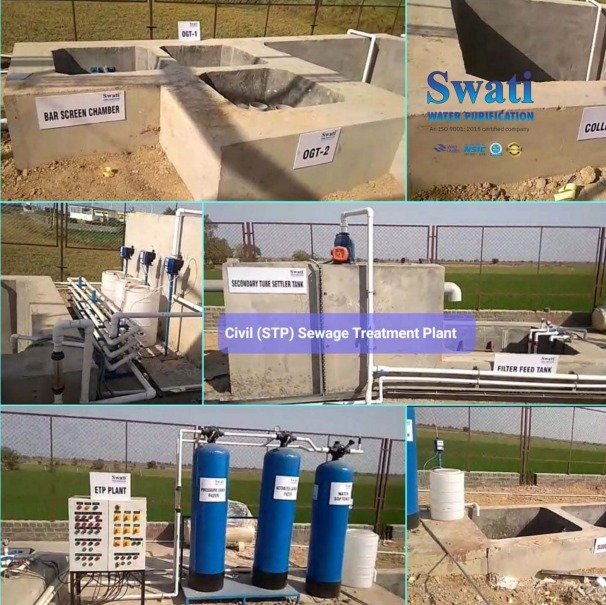Civil STP (Sewage Treatment Plant)
Swati Water Purification – Civil STP (Sewage Treatment Plant) Supplier, Civil STP (Sewage Treatment Plant) Manufacturer.

Civil STP (Sewage Treatment Plant)
A Civil STP (Sewage Treatment Plant) refers to a facility that is designed for the treatment of domestic or municipal sewage in civil engineering applications. It is used to treat wastewater generated from homes, industries or municipalities to make it safe for disposal into the environment or for reuse. The treated water typically meets environmental standards set by local authorities to prevent pollution and ensure public health.
CIVIL STP Plant is also known as, “Sewage Treatment Plant (STP),” “Wastewater Treatment Plant (WWTP),” “Effluent Treatment Plant (ETP),” “Packaged Sewage Treatment Plant,” “Activated Sludge Process,” “Membrane Bioreactor (MBR),” “Moving Bed Bio Reactor (MBBR),” “Sequential Batch Reactor (SBR),” “Rotating Bio Reactor,” “Wastewater Recycling Plant,” “Domestic Sewage Treatment Plant,” “Municipal Sewage Treatment Plant,” “Industrial Sewage Treatment Plant.”
We Are Manufacturers & Suppliers In Ahmedabad, Gandhinagar, Gujarat, India, Sanand GIDC, Mehsana, Vitthalapur, Mandal Bechraji Special Investment Region(MBSIR), Halol GIDC, Bavla Kerala GIDC, Dahej SIR & PCPIR(Petroleum, Chemicals and Petrochemicals Investment Region), Dholera SIR, GIDC Industrial Area(Gujarat Industrial Development Corporation), MIDC Industrial Area(Maharashtra Industrial Development Corporation), MPIDC Industrial Area(Madhya Pradesh Industrial Development Corporation), RIICO Industrial Area(Rajasthan State Industrial Development & Investment Corporation), PSIDC(Punjab State Industrial Development Corporation), SEZs Area(Special Economic Zones), SEEZ Area(Solar Energy Enterprises Zone) In Rajasthan, Peenya Industrial Area In Bengaluru(Bengalore, Karnataka) etc..
Capacities Of CIVIL STP Plant:
- Small-Scale STP: Up to 100 KLD (for small residential complexes or commercial buildings).
- Medium-Scale STP: 100 to 500 KLD (for medium-sized industries, housing societies or hotels).
- Large-Scale STP: 500 to 5,000 KLD (for large municipalities, industries or commercial complexes).
- Very Large-Scale STP: 5,000 KLD or More (for large industrial plants or power stations)
The Capacity depends on factors like the amount of wastewater generated and the required treatment.
How to Work:
1. Preliminary Treatment: Large debris and solid waste are removed using screens or grit chambers.
2. Primary Treatment: Settling tanks allow heavier solids to settle at the bottom, while oils and fats float to the surface and are skimmed off. 3. Secondary Treatment: Microorganisms (Bacteria) breakdown remaining organic matter in aeration tanks (activated sludge or trickling filters).
4. Tertiary Treatment: Further filtration, chemical treatment, or UV disinfection is used to remove any remaining contaminants and improve water quality.
5. Sludge Treatment: The accumulated sludge is treated (e.g., through digestion or dewatering) before disposal or reuse.
This process ensures that wastewater is cleaned and returned to the environment or reused safely.
Applications of CIVIL STP Plant:
1. Chemical Manufacturing: Treats wastewater containing harmful chemicals and metals, ensuring safe discharge and sometimes enabling water reuse.
2. Pharmaceutical & Biotechnology: Removes active pharmaceutical ingredient and solvents to prevent contaminants and comply with regulations.
3. Food & Beverage: Treats organic waste from production, allowing water reuse in non-potable application like cleaning.
4. Textile: Removes dyes and chemicals, helping minimize pollution and recycling water for washing or dyeing processes.
5. Pulp & Paper: Treats wastewater with fibers and chemicals, allowing for water reuse in production and reducing environmental impact.
6. Mining: Treats wastewater with heavy metals and acids, enabling safe disposal or reuse.
7. Oil & Gas: Treats Produced water, removing hydrocarbons and chemicals for safe discharge or recycling.
8. Power Plants: Treats cooling tower blow down water for discharge or reuse, ensuring environmental compliance.
9. Automobile Manufacturing: Treats paint shop wastewater and cooling system water to prevent pollution and reduce water usage.
